
Last update: April 6, 2007


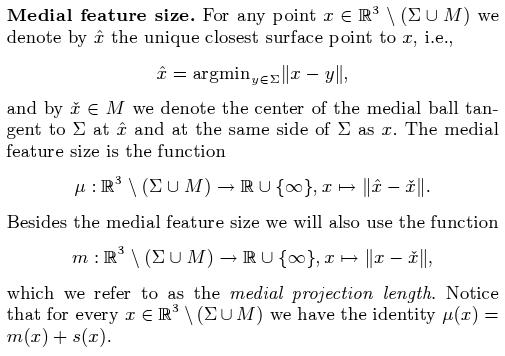
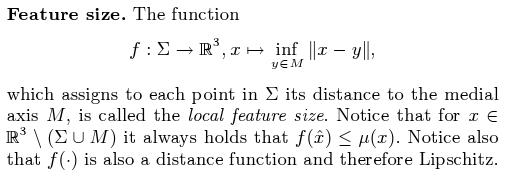
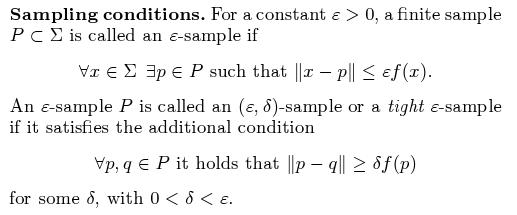





Web links:
Geometric shapes are identified with their features. For computational purposes a concrete mathematical definition of features is required. In this paper we use a topological approach, namely dynamical systems, to define features of shapes. To exploit this definition algorithmically we assume that a point sample of the shape is given as input from which features of the shape have to be approximated. We translate our definition of features to the discrete domain while mimicking the set-up developed for the continuous shapes. Experimental results show that our algorithms segment shapes in two and three dimensions into so-called features quite effectively. Further, we develop a shape matching algorithm that takes advantage of our robust feature segmentation step.
Proceedings of the 8th International Fall Workshop on
Vision, Modeling, and Visualization (VMV),
pp. 235-243, Munich, Germany, November 2003.
Proc. 35rd Annual ACM Symposium on the Theory of
Computing (STOC),
pp. 493-501, San Diego, CA, June 2003.
Web links:
In this paper we establish a topological similarity between two apparently different shape constructors from a set of points. Shape constructors are geometric structures that transform finite point sets into continuous shapes. Due to their immense practical importance in geometric modeling various shape constructors have been proposed recently. Understanding the relations among them often leads to new insights that are potentially helpful in applications. Here we discover a topological equivalence among two such geometric structures, namely ? shapes and flow shapes. Both shapes found applications in surface reconstruction and molecular modeling.
Proc. of the 14th Annual ACM-SIAM Symposium on
Discrete Algorithms (SODA),
pp. 285-294, Baltimore, Maryland, 2003.
Web links:
Structuring finite sets of points is at the heart of computational geometry. Such point sets arise naturally in many applications. Examples in R³ are point sets sampled from the surface of a solid or the locations of atoms in a molecule. A first step in processing these point sets is to organize them in some data structure. Structuring a point set into a simplicial complex like the Delaunay triangulation has turned out to be appropriate for many modeling tasks. Here we introduce the flow complex which is another simplicial complex that can be computed efficiently from a finite set of points. The flow complex turned out to be well suited for surface reconstruction from a finite sample and for some tasks in structural biology. Here we study mathematical and algorithmic properties of the flow complex and show how to exploit it in applications.
J. Giesen and M. John
Proc. of the 23rd Annual Conf. of the European
Association for Computer Graphics (Eurographics)
Computer Graphics Forum, vol. 21, issue 3, pp. 363-371, September 2002.
We present an efficient algorithm that computes a manifold triangular mesh from a set of unorganized sample points in IR3. The algorithm builds on the observation made by several researchers that the Gabriel graph of the sample points provides a good surface description. However, this surface description is only one-dimensional. We associate the edges of the Gabriel graph with index 1 critical points of a dynamical system induced by the sample points. Exploiting also the information contained in the critical points of index 2 provides a two-dimensional surface description which can be easily turned into a manifold.
J. Giesen and M. John
Proc. of the 14th Canadian Conf. on Computational
Geometry (CCCG),
pp. 45-48, University of Lethbridge, Alberta, Canada, August 2002.
Web links:
Computational Geometry, vol. 21, Issues 1-2, pp. 63-86, January 2002.
Earlier version as conference proceedings at Vis.'2000 (below).
We present a new approach to surface reconstruction in arbitrary dimensions based on the Delaunay complex. Basically, our algorithm picks locally a surface at each vertex. In the case of two dimensions we prove that this method gives indeed a reconstruction scheme. In three dimensions we show that for smooth regions of the surface this method works well and at difficult parts of the surface yields an output well-suited for postprocessing. As a postprocessing step we propose a topological clean up and a new technique based on linear programming in order to establish a topologically correct surface. These techniques should be useful also for many other reconstruction algorithms.
Author Keywords: Surface reconstruction; Gabriel graph; Linear programming
A Delaunay simplex is s.t. that their exist an open ball empty of points of the finite set, S in R^d, other than the k (k <= d+1) points defining the ball (. The Delaunay complex (DC) is the collection of all such simplices.
The Alpha-shape (Edelsbrunner et al., 1994), is a sub-complex of the DC, s.t. each of its k-simplex corresponds to a maximal contact ball with radius alpha. For the purpose of surface reconstruction, consider only simplices of dimension k = d-1 (e.g., triangles in 3D).
The Beta-skeleton (Kirkpatrick & Radke, '1985) is a (d-1) complex defined by a forbidden zone as follows. Consider a (d-1) simplex sigma with d vertices. The simplex belongs to the Beta-skeleton, iff the union of the two d-dimensional balls tangent to the d vertices with diameter Beta * diam(sigma) is empty, where diam(sigma) is the smallest diameter of the balls.
The Lambda-complex adapts to varying sampling density but is less restrictive than the Beta-skeleton. Let diam(sigma) be the diameter of the smallest circumscribed ball for a (d-1) simplex sigma. A Lambda-ball b_l(sigma) is an open d-dimensional ball with diameter diam(sigma)/l, l in (0,1], with all its vertices at its boundary. For l=0, b_l(sigma) is an open halfspace through the vertices of sigma.

NB: A Gabriel simplex is such that l = 1, i.e., it corresponds to the smallest circumscribed ball through d points. In 3D, it is the triangle of the maximal contact sphere through a triplet of points.


E.g., in 3D, consider a triangle as sigma. This triangle is the face of a pair of (Delaunay) tetrahedra, sigma_1 and sigma_2 (unless one of these recedes to infinity, i.e., sigma is a face of the convex hull of the set S).
NB: Consider the pair of A_1^4 shock nodes associated to the A_1^3 shock curve, dual to the triangle. They give directly the two diameters diam(sigma_i). Thus, this concept is similar to the idea (of Amenta et al.) of using "poles". That is, favor the triangles having associated longer shock curves (intituitively, longer or better defined "normals").




Lines 10-13 :
See text.
The umbrella check at a vertex v is done by constructing a graph G_v with vertex set V_v (the set of all vertices adjacent to v in the Gabriel complex). Each time a new triangle <v,v_1,v_2> is added to ChosenSimplices_v, the vertices v_1 and v_2 are connected by an edge in G_v. An umbrella at v is then a cycle in G_v.

In practice, the above procedure does not always lead to a topologically correct surface.

NB: Condition (b) above does not permit to have a boundary for a surface (the assumption is one of a closed bounded surface).
3 types of triangle sets which do not fulfill the "umbrella condition" (of existence, simplicity or uniqueness):
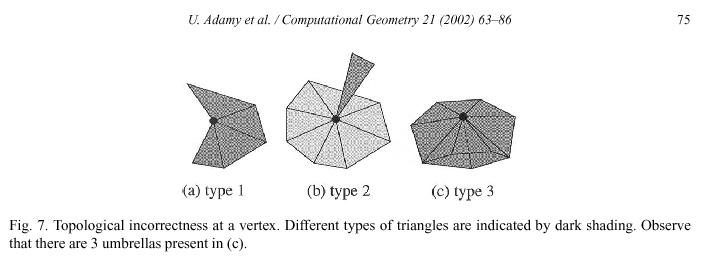
Delete type 2 triangles (direct).
Delete type 3 triangles in reverse order of the lower bounds of their Lambda-intervals (i.e., favor small lower Lambda-intervals). NB: this may make some remaining triangles of type 2.
A subset of vertices with type 1 triangles may correspond to [a] hole(s), H.
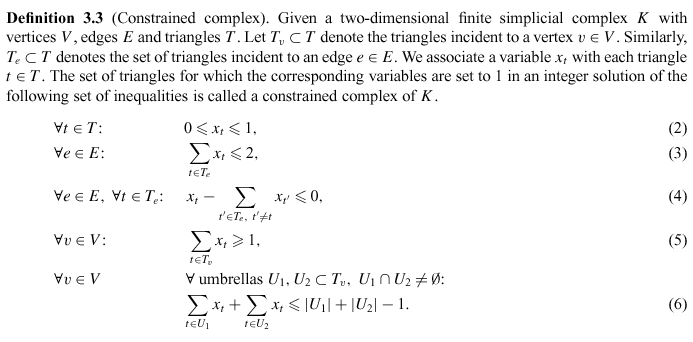
Proc. of the 11th Ann. IEEE Visualization Conference
(Vis) 2000,
Salt Lake City, Utah, USA, pages 373-380.
NB: Earlier version of the journal paper (above).
We present a new approach to surface reconstruction based on the Delaunay complex. First we give a simple and fast algorithm that picks locally a surface at each vertex. For that, we introduce the concept of lambda-intervals. It turns out that for smooth regions of the surface this method works very well and at difficult parts of the surface yields an output well-suited for postprocessing. As a postprocessing step we propse a topological clean up and a new technique based on linear programming in order to establish a topologically correct surface. These techniques should be useful also for many other reconstruction schemes.
Page created & maintained by Frederic Leymarie,
2003-7.
Comments, suggestions, etc., mail to: ffl(at)gold(dot)ac(dot)uk